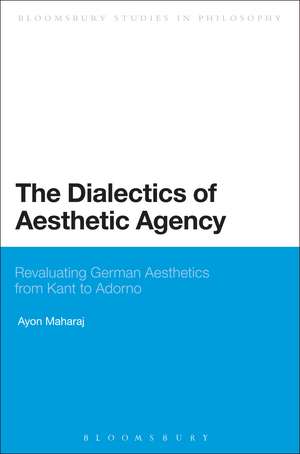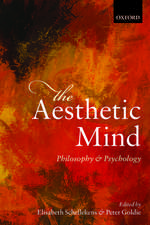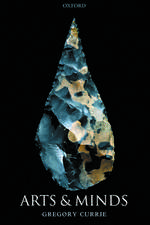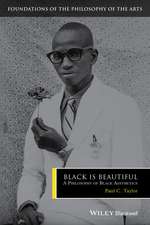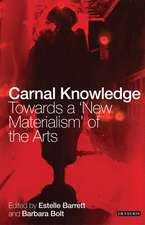The Dialectics of Aesthetic Agency: Revaluating German Aesthetics from Kant to Adorno: Bloomsbury Studies in Philosophy
Autor Dr Ayon Maharajen Limba Engleză Paperback – 16 iul 2014
| Toate formatele și edițiile | Preț | Express |
|---|---|---|
| Paperback (1) | 256.77 lei 6-8 săpt. | |
| Bloomsbury Publishing – 16 iul 2014 | 256.77 lei 6-8 săpt. | |
| Hardback (1) | 890.28 lei 6-8 săpt. | |
| Bloomsbury Publishing – 2 ian 2013 | 890.28 lei 6-8 săpt. |
Din seria Bloomsbury Studies in Philosophy
- 13%
 Preț: 257.50 lei
Preț: 257.50 lei - 22%
 Preț: 256.20 lei
Preț: 256.20 lei - 22%
 Preț: 257.03 lei
Preț: 257.03 lei - 13%
 Preț: 255.47 lei
Preț: 255.47 lei - 22%
 Preț: 237.28 lei
Preț: 237.28 lei - 22%
 Preț: 257.50 lei
Preț: 257.50 lei - 22%
 Preț: 773.81 lei
Preț: 773.81 lei - 13%
 Preț: 256.20 lei
Preț: 256.20 lei - 22%
 Preț: 258.89 lei
Preț: 258.89 lei - 13%
 Preț: 255.11 lei
Preț: 255.11 lei -
 Preț: 256.20 lei
Preț: 256.20 lei - 22%
 Preț: 772.58 lei
Preț: 772.58 lei - 22%
 Preț: 240.50 lei
Preț: 240.50 lei - 22%
 Preț: 257.03 lei
Preț: 257.03 lei - 23%
 Preț: 255.84 lei
Preț: 255.84 lei - 23%
 Preț: 255.29 lei
Preț: 255.29 lei - 13%
 Preț: 237.28 lei
Preț: 237.28 lei - 13%
 Preț: 235.00 lei
Preț: 235.00 lei -
 Preț: 258.42 lei
Preț: 258.42 lei -
 Preț: 256.49 lei
Preț: 256.49 lei - 14%
 Preț: 773.06 lei
Preț: 773.06 lei - 30%
 Preț: 774.03 lei
Preț: 774.03 lei - 30%
 Preț: 774.20 lei
Preț: 774.20 lei - 30%
 Preț: 774.86 lei
Preț: 774.86 lei
Preț: 256.77 lei
Preț vechi: 295.03 lei
-13% Nou
Puncte Express: 385
Preț estimativ în valută:
49.14€ • 51.11$ • 40.57£
49.14€ • 51.11$ • 40.57£
Carte tipărită la comandă
Livrare economică 14-28 aprilie
Preluare comenzi: 021 569.72.76
Specificații
ISBN-13: 9781472579591
ISBN-10: 1472579593
Pagini: 208
Dimensiuni: 156 x 234 x 12 mm
Greutate: 0.33 kg
Editura: Bloomsbury Publishing
Colecția Bloomsbury Academic
Seria Bloomsbury Studies in Philosophy
Locul publicării:London, United Kingdom
ISBN-10: 1472579593
Pagini: 208
Dimensiuni: 156 x 234 x 12 mm
Greutate: 0.33 kg
Editura: Bloomsbury Publishing
Colecția Bloomsbury Academic
Seria Bloomsbury Studies in Philosophy
Locul publicării:London, United Kingdom
Caracteristici
Lays the groundwork for a dialectical approach to art, reviving the discourse of aesthetic agency.
Notă biografică
Ayon Maharaj is Assistant Professor in the Departments of Philosophy and English at Ramakrishna Mission Vivekananda University in West Bengal, India.
Cuprins
PrefaceAcknowledgementsAbbreviations of Primary TextsIntroduction: The Crisis of Art in Modernity1. Aporias of Aesthetic Pleasure in Kant's 'Analytic of the Beautiful'2. The "Great Gulf" of the Third Critique: Kant's Ambivalence about the Role of Aesthetic Pleasure in Moral Lif3. Kant Romanticized: Aesthetic Intuition as Redemption in Schelling's System of Transcendental Idealism 4. Hegel contra Schlegel: On the Aporetic Epistemology of Romantic Irony5. Art's 'After' and the Dialectical Possibilities of Irony in Hegel's Lectures on Aesthetics6. The Idealist Legacy: Adorno's Dialectical Retrieval of Aesthetic Agency in Aesthetic TheoryEpilogue: Art as Force: From Critical Suspicion to Dialectical ImmanenceNotesBibliographyIndex
Recenzii
How can we both be enraptured and shaken by the experience of art and yet also continuously suspicious of art's promises, seductions, and potentially dangerous uses? Is this complex attitude even coherent, let alone fruitful? By tracing and evaluating the stances on art of Kant, Schelling, Schlegel, Hegel, Kierkegaard, and Altieri, Ayon Maharaj arrives at a compelling account of the work of art as a haunting force that eludes both reduction to any definite message and dismissal as an empty entertainment. In this way, Maharaj brings the tradition of German aesthetic theory strikingly to life in relation to current plights and possibilities of human life in culture.
Maharaj's book offers consistent and intense philosophical analyses of the basic arguments shaping the aesthetic theories of Kant, Schelling, Schiller, Nietzsche, and Adorno. But Maharaj also pursues more elaborate ambitions that make its path through those arguments a compelling statement of what might be possible for this mode of self-reflection. Because aesthetics has our pleasure in imagined objects at its core, these philosophers used these inquiries to establish powers of human agency that could find a home nowhere else in Enlightenment philosophy. One might imagine aesthetics charged with the role of a new theology articulating the project of restoring aspects of the sacred within a disenchanted world. Because Maharaj elaborates so compelling a sense of this shared project, it seems as if the commentator ultimately has the task of composing a dialectical structure articulating how the mind finds a satisfying home in a most unsatisfying world. It is no accident that he concludes with Adorno.
The real strength of Maharaj's account comes in the patient and detailed narrative he develops of the infuence of this aporetic reading of Kant, from Schiller through to figures as late as Theodor Adorno ... develops a number of original and searching accounts ... the author persuasively develops a fresh reading of Hegel's philosophy as based on a dialectical development and appreciation of Schelgelian irony ... This book succeeds admirably in articulating a fresh and coherent genealogy of post-Kantian aesthetics. Its impressive range has not prevented its author from producing incisive and original work on all the philosophers it incorporates.
An original and meticulously crafted account of aesthetic agency in its conceptual evolution from Kant to Adorno . . . What sets this work apart from comparable works exploring the art-agency relation from Kant onward is that it deftly plays between antithetical attitudes toward the notion of aesthetic agency. . . The work presents a historically grounded analysis of how these competing tendencies of art -- enchantment and disenchantment -- stand in various stages of dialectical interdependence with one another. . . One has to commend this work as a powerful and timely defense of aesthetic agency. It is a welcome line of argument for those of us who can neither naively ascribe to art the power of spiritual redemption nor cynically reduce art to the purpose of entertainment, pleasure, or emotional catharsis.
Maharaj's book offers consistent and intense philosophical analyses of the basic arguments shaping the aesthetic theories of Kant, Schelling, Schiller, Nietzsche, and Adorno. But Maharaj also pursues more elaborate ambitions that make its path through those arguments a compelling statement of what might be possible for this mode of self-reflection. Because aesthetics has our pleasure in imagined objects at its core, these philosophers used these inquiries to establish powers of human agency that could find a home nowhere else in Enlightenment philosophy. One might imagine aesthetics charged with the role of a new theology articulating the project of restoring aspects of the sacred within a disenchanted world. Because Maharaj elaborates so compelling a sense of this shared project, it seems as if the commentator ultimately has the task of composing a dialectical structure articulating how the mind finds a satisfying home in a most unsatisfying world. It is no accident that he concludes with Adorno.
The real strength of Maharaj's account comes in the patient and detailed narrative he develops of the infuence of this aporetic reading of Kant, from Schiller through to figures as late as Theodor Adorno ... develops a number of original and searching accounts ... the author persuasively develops a fresh reading of Hegel's philosophy as based on a dialectical development and appreciation of Schelgelian irony ... This book succeeds admirably in articulating a fresh and coherent genealogy of post-Kantian aesthetics. Its impressive range has not prevented its author from producing incisive and original work on all the philosophers it incorporates.
An original and meticulously crafted account of aesthetic agency in its conceptual evolution from Kant to Adorno . . . What sets this work apart from comparable works exploring the art-agency relation from Kant onward is that it deftly plays between antithetical attitudes toward the notion of aesthetic agency. . . The work presents a historically grounded analysis of how these competing tendencies of art -- enchantment and disenchantment -- stand in various stages of dialectical interdependence with one another. . . One has to commend this work as a powerful and timely defense of aesthetic agency. It is a welcome line of argument for those of us who can neither naively ascribe to art the power of spiritual redemption nor cynically reduce art to the purpose of entertainment, pleasure, or emotional catharsis.
